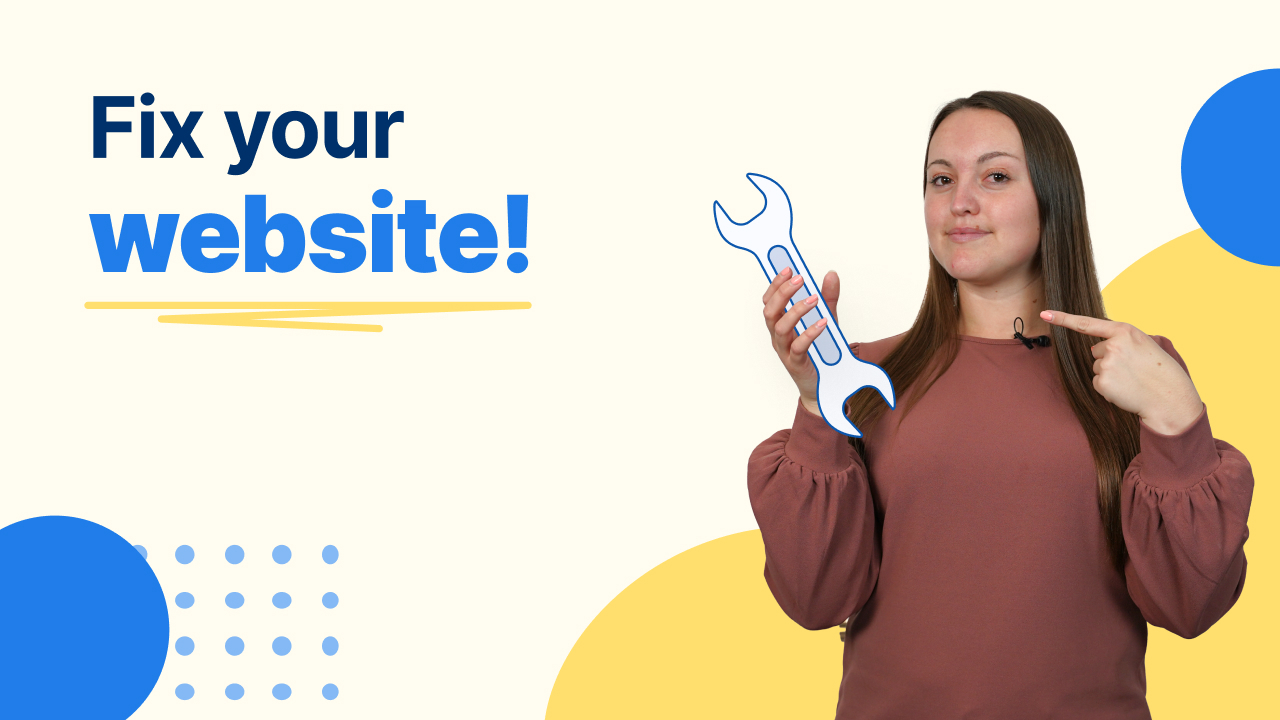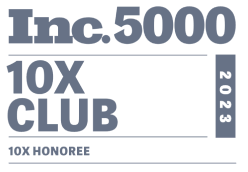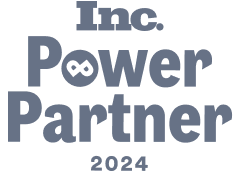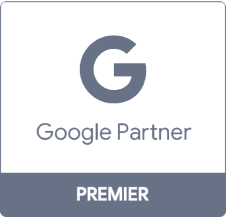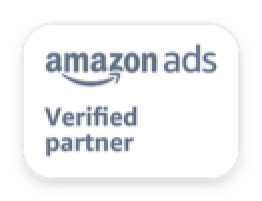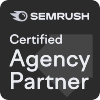- Home
- Digital Marketing
- Learn
- Increase Website Traffic
30 Fool-Proof Ways to Increase Website Traffic in 2025
Site traffic is vital to driving conversions, sales, and revenue on your website. But generating site traffic can be difficult, especially if you’re not an expert in website marketing.
The good news is, we’re here to help you improve your site traffic with a list of traffic-driving tips you can use. Keep reading to view the full list. And if you want to learn more about digital marketing, be sure to subscribe to our newsletter, Revenue Weekly!
How to increase website traffic for your business
To help you drive more website traffic, we’ve prepared 30 tactics you can use. These tactics are divided into the following categories:
- Attract interested prospects with content marketing
- Boost your site in rankings with on-page SEO
- Expand your reach beyond your website with off-page SEO
- Harness other marketing strategies to reach a wider audience
- Measure and reoptimize your campaigns with analytics
- Other miscellaneous tactics to drive traffic
Keep reading to discover how to increase website traffic with these 30 effective strategies!
Attract interested prospects with content marketing
One of the most vital components of a good website is content. Here are some content-related tips for increasing your website traffic:
- Create compelling written content
- Optimize your titles and meta descriptions
- Identify relevant, long-tail keywords
- Incorporate plenty of photos and graphics
- Produce engaging video content
- Optimize for voice search
- Entice users with a free tool
- Make consistent site content updates
Keep reading to learn more!
1. Create compelling written content
As we just mentioned, content creation is a crucial strategy for increasing site traffic. Without content, Google has nothing to rank, which means you likely won’t find yourself ranking on the first page (if at all) in search results.
For the purposes of helping Google understand your site, the best type of content to use is written content. You can create a variety of written content, and the more you have, the better. Here are some common types of content that you can use on your website:
| Content type | Definition | Main benefit |
| Long-form content | Content that’s longer than 2000 words | Loved by Google because it shows that you’re an expert on a subject |
| Informational pages | Content that teaches readers about a certain topic related to your business | Shows Google that you are knowledgeable in your industry |
| Product or service pages | Pages that talk about your products and services | Can target ultra-specific keywords depending on the product or services |
| Guides | Downloadable content that provides extensive information about specific topics | Talks at length about a topic, targeting more than just a few keywords |
| Blog posts | Fresh, consistently scheduled pieces of shorter-form content | Provides Google with a steady stream of new content to rank and shows that you keep up with the industry |
High-quality content helps increase your visibility online and gives users more reason to visit your website. It’s essential for increasing website traffic.
2. Optimize your titles and meta descriptions
When your content appears in search results, it’s not as though the whole article will show up right there in Google. Instead, users will see two main elements: The title tag and the meta description. Both of these elements are crucial, because they’re what leads users to click on your content (or not).
A title tag is a blue link that shows up with your content in search results. A title could make or break the success of a piece of content, and over time, if enough people aren’t clicking your title tag, you could see a drop in site traffic. Below, the arrows point to the title tags.
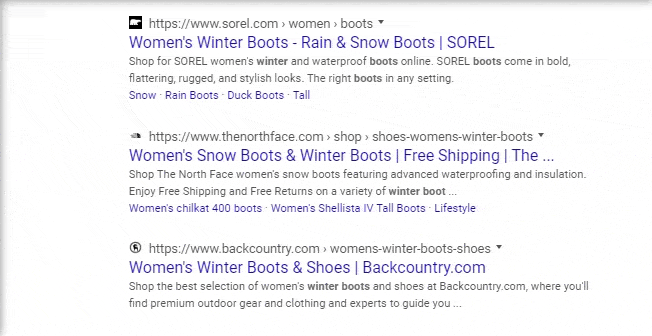
Your title tag should include your most important keywords (which we’ll talk about in a moment). It should also make users want to click to learn more.
Your meta description, on the other hand, is — well — a description of your content. This can also make or break a click since the way you position your content has a huge effect on whether or not people want to visit your page. Below, the arrows point to the meta descriptions.
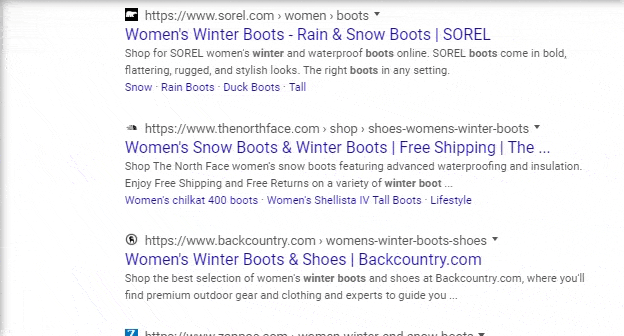
3. Identify relevant, long-tail keywords
Keyword research is the base of any SEO campaign. Keywords are paramount for attracting users to your website, and choosing the right ones with keyword research can take your website traffic to the next level. By including keywords in your content, you can signal to Google that your content should rank for those keywords.
Of course, you shouldn’t just target any keywords. You want to target keywords that are relevant to your business, and you also want to focus on long-tail keywords — that is, those that are several words long — because they’re more specific and come with less competition in search results.
That’s where keyword research comes into play. Research can show you which keywords are ideal for you to target. There are multiple ways to find new keywords, such as using free tools like KeywordsFX.
If you don’t target keywords that your audience searches, you won’t ever attract them to your website. It’s like a restaurant offering a prized dish, but not putting it on their menu. To attract tons of qualified traffic to your website, you must do keyword research.
4. Incorporate plenty of photos and graphics
It’s important to have written content on your site so that Google is able to read it. That being said, you don’t want all your pages to be nothing but giant walls of text. That’s not very appealing to look at, and it can quickly turn off users who were initially interested.
So, how do you counteract that problem? Simple — you intersperse that written content with images like photos and graphics. Of course, these images shouldn’t be random. They should relate to the content they appear in. But you do want to make them engaging.
Images like infographics are especially good at this, because they can be visually appealing and informational at the same time. That will help keep users on your site longer, increasing their chances of visiting more pages and eventually converting.
5. Produce engaging video content
Still images aren’t the only form of visual content. You can (and should) also use video content, which is one of the most engaging types of content out there. You can post videos not only on your website, but also on other sites like YouTube (which you can then link back to your own site).
Not only that, but videos have the potential to go viral, spreading your website URL far and wide. Between that and the fact that many users prefer video content over other types, it’s definitely a strategy you want to take advantage of.
6. Optimize for voice search
We’ve already talked about targeting keywords in your content. But in particular, you should be sure to optimize for voice search. People often use voice search to get quick answers to their questions online, so you should target keywords that reflect that.
For the most part, that means targeting long-tail keywords, which we’ve already mentioned. To be more specific, though, you should target keywords that take the form of full sentences, particularly questions. Then optimize your content to quickly answer those questions near the top of the page.
With any luck, that type of optimization will help your content appear in featured snippets for those keywords. Featured snippets are where Google shows a small piece of your content right at the top of search results. It’s a great way to draw in fresh traffic, and it’s also exactly what people want when they use voice search.
7. Entice users with a free tool
This is a little different from the other tips in this section, but in addition to offering informational content, you could also consider providing access to free tools. For example, if you run a finance company, you might include a few simple budgeting tools on your website for free.
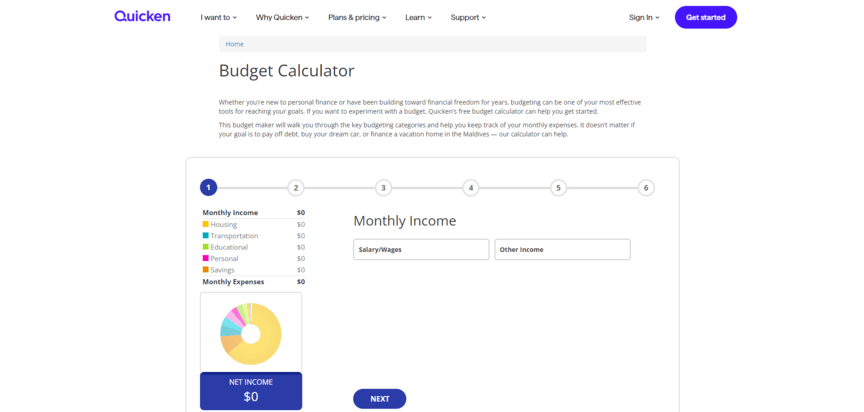
These tools will draw in people who need help with something in your industry. After they use the tools, they might later need help with more complex problems, at which point they might seek out your products or services.
Like informational content, providing free tools on your site is a great way to draw in more traffic and help them remember your company as a source of help for their problems.
8. Make consistent site content updates
So far, we’ve talked only about creating new content. But eventually, that content will likely grow outdated, which will make it a lot less helpful. So… what then?
Well, to resolve that issue, the simplest thing to do is to consistently update your website content over time. It’s great not only for your SEO, but also for users. Here are some of the main things that updating your content does for you:
- Shows Google that you consistently try to stay ahead of the curve
- Shows users that you have a lot of knowledge to share
- Provides Google with a steady stream of new pages to index and rank
- Gives users a reason to return to your website
You can also make this a little easier on yourself by creating evergreen content, which is content that’s designed to stay relevant for a long time. You can do that by writing content that avoids mentioning specific topics or events that will be dated after a few years. That means you don’t have to update it as frequently.
Boost your site in rankings with on-page SEO
The basis of web traffic may hinge on content, but that doesn’t mean you shouldn’t also consider other aspects of your website. You want all the pages on your site to be optimized for search results in a more technical aspect, too. For that reason, here are a few on-page SEO tips to take note of:
- Optimize for the user experience
- Improve your page load speeds
- Use responsive web design
- Harness schema markup
- Optimize your page URLs
- Use internal linking across your site
Read on to find out more about each one.
1. Optimize for the user experience
Google ranks websites based on the quality of their content and how beneficial it believes a page will be to users with a specific query.
User experience (UX) plays a big role since Google’s goal is to provide users with the best possible experience. If your website doesn’t provide a fantastic UX, you’ll have a harder time ranking high in search results. Here are a few site elements that affect user experience:
- Use of graphics throughout the content
- A simple, effective navigation bar
- Use of call-to-action buttons
- Use of live chatbots to answer questions
- Overall aesthetic appearance of your website
2. Improve your page load speeds
The speed of your website can be a huge site deterrent and even keep users from returning. When users click to a page on your site, they want the information that you have to offer, and they want it now.
The ideal load time is two to five seconds, but every second that surpasses the two-second mark results in higher bounce rates. Bounce rate is the percentage of single-page sessions on your site — that is, the percentage of users that only visited a single page before leaving your site.
You can improve your page speeds by taking the following steps:
- Limiting redirects
- Minifying code
- Compressing images
- Caching web pages
3. Use responsive web design
When you have a responsive site, it simply means that users who opt to view your site on a mobile device or a tablet will have the same experience as someone viewing your site on a desktop computer. Responsiveness is more important than ever, especially with Google’s mobile-first indexing.
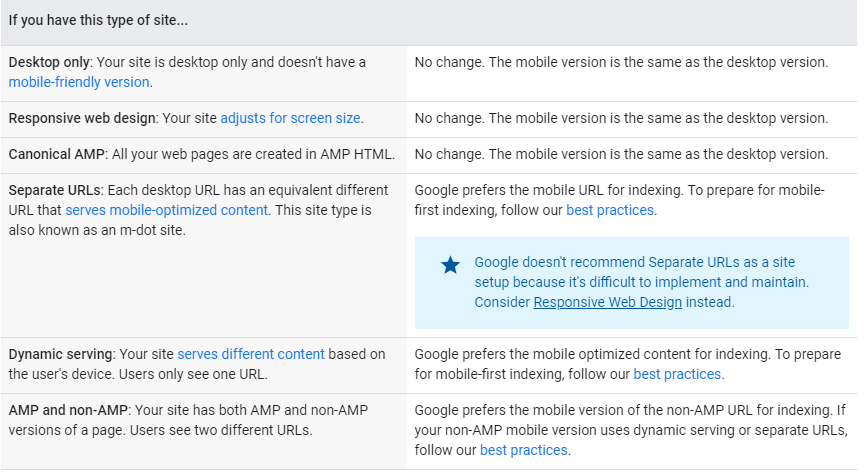
Mobile-first indexing is where Google primarily uses the mobile version of a website for indexing and ranking. Usability is a ranking factor to Google, and they may rank you lower in search results if your site isn’t responsive to all users on all devices.
4. Harness schema markup
Another way to boost your on-page SEO is to use schema markup. Schema markup is a type of coding that you use on a page to provide Google with more information about the page’s content, which then appears in search results (typically underneath the meta description).
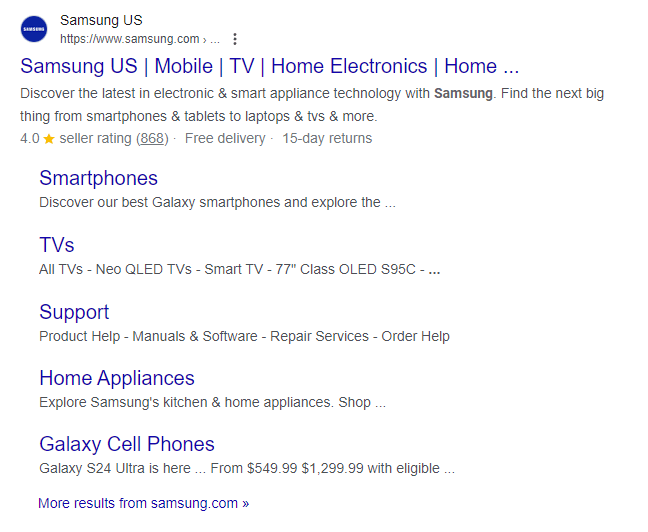
This additional information helps users better grasp the value of your page, making them more likely to click on it when they see it in search results. Ultimately, that leads to more traffic for your website.
5. Optimize your page URLs
You might think your page URLs aren’t going to affect whether or not people visit those pages — but you’d be wrong. Not only does Google display the URL along with the title tag and meta description, but users are also likely to look at the URL before clicking a link from another website.
That means you need your URLs to be clear about where they lead, as well as short and simple. Your URL should be user-friendly if you want it to result in a click to your website. Here are a few URL best practices to follow:
- Shorter is better
- It should include your main target keyword
- Stay away from long strings of numbers
- Stay away from extra punctuation
In summary, when it comes to URLs, the shorter and simpler, the better.
6. Use internal linking across your site
Internal linking is another SEO strategy that helps you increase website traffic. With this strategy, you place links to your content on other pages across your website.
For example, if you owned a pet store, you could write a blog post about puppy breeds. In that blog, you could link to different puppy products that you have pages for on your site.
Not only does internal linking help users to stay on your site for a longer time, but it also helps Google find and index your pages faster — which means it can rank them more quickly as well.
Expand your reach beyond your website with off-page SEO
Now that we’ve gone over some tips for on-page SEO, let’s move on to off-page SEO — that is, SEO tactics that take place outside of your website. Those tactics include:
Keep reading to learn more about these off-page methods!
1. Earn reputable backlinks
We just talked about the value of linking between different pages on your site. But you know what’s even more valuable than internal links? External ones. When other sites link to your content, it can really help your SEO. These are called backlinks.
That’s particularly true if you can earn links from reputable websites in your industry. If a reputable website links to your content, that signals to Google that your content must be reputable as well, so it ranks you higher in search results.
So, how do you earn backlinks? Well, step one is to simply create high-quality content. But if you want to take a more active role, you can check out some authoritative sites in your industry and look for missing or broken links. If you find any, you can recommend to the site owners that they replace those links with fresh ones to your content.
2. Optimize your local SEO
Local SEO is a specific type of SEO that focuses on marketing to people in your local area. Some of that happens on your website — for example, you can incorporate keywords like “[your type of business] near me.” But a lot of local SEO happens off-page.
One of the biggest ways you can improve your local SEO is by setting up a Google Business Profile. You may have seen these profiles before in local 3-packs, which are a special type of search result that shows up at the top of the page. These 3-packs show three local businesses that match the search query.
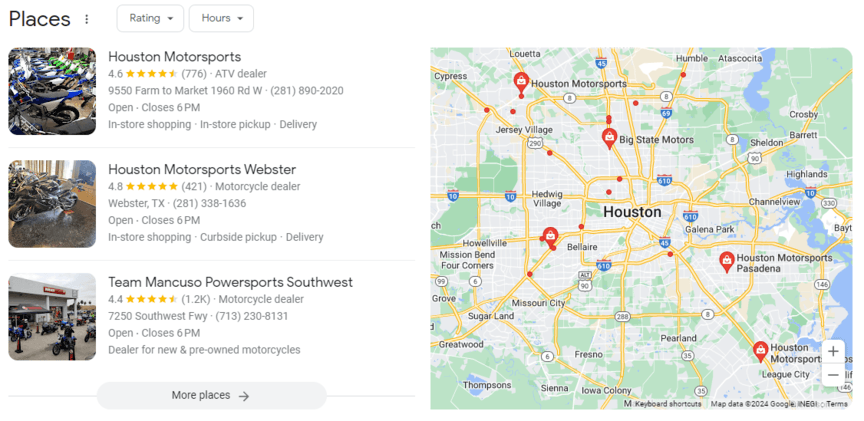
By setting up a Google Business Profile of your own, you can gain a shot at appearing in those 3-packs. To optimize your profile, be sure to fill out as much information as you can.
3. Get on some business listing websites
A Google Business Profile isn’t the only way to get your name out on the Internet. You can also get your company onto other listing websites. Often, there will be sites dedicated to listing (and rating) companies in specific industries, particularly if you work in a home services industry like pest control or HVAC.
By getting your business listed on those sites and building up positive reviews there — which you can do by providing stellar service and then encouraging your customers to leave reviews — you can really increase your presence in search results (particularly local ones).
That doesn’t just apply to industry-specific listing sites, either. There are several general listing sites out there, such as the Yellow Pages.
Harness other marketing strategies to reach a wider audience
So far on this page, we’ve talked exclusively about SEO and content marketing. And that makes sense, because those are the main strategies dedicated specifically to driving website traffic. But that doesn’t mean that other digital marketing strategies can’t contribute as well — because they can.
Here are a few other strategies you can use to bring more people to your site:
- Run PPC ads in search results
- Share your content on social media
- Run paid social media ads
- Send out marketing emails
Read on to learn more about each of these strategies.
1. Run PPC ads in search results
Opting for search engine advertising is one of the best ways to help increase your website quickly. Why?
It’s all in how pay-per-click (PPC) advertising works. You’ll start by bidding for a keyword that is relevant to one of the products or services that you sell. Your bid is how much you’re willing to pay every time someone clicks your ad — which means you’re not paying for ad space, just clicks.
This also makes PPC one of the most cost-effective strategies to increase traffic to your website. With a high enough bid and Ad Rank, your ad will show up at the top of search results, earning you valuable real estate in Google.
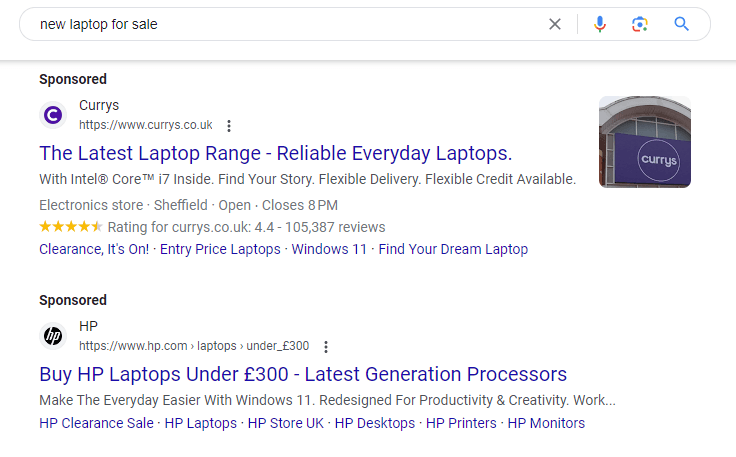
Talk about a prime location for clicks!
2. Share your content on social media
Given how widely used social media is today, it shouldn’t be surprising that social media marketing is one of the best ways to increase website traffic. No matter who your target audience is, you’re bound to find at least a pocket of that audience on one or more social platforms.
There are a variety of content types that you can post on your social media accounts. However, if we’re talking specifically about increasing traffic to your website, the most effective type of social posts are those that share links to content on your site. When you share links to your website’s blog, for instance, interested users will visit your website in just one click.
To increase clicks, be sure to have a creative caption and even an image to entice users to click on those website links.
3. Run paid social media ads
Organic posts aren’t the only way to use social media. Most social media platforms come with their own ad platforms, making it extremely easy and intuitive to place ads there. Social media ads typically work the same as search engine PPC ads, where you choose how much you’re willing to pay when users click your ads.
Feel free to experiment with cost per click until you find an amount that benefits your strategy and keeps you on budget. Like PPC ads, these ads will ultimately lead users to landing pages on your website, which will help increase both site traffic and conversions.
4. Send out marketing emails
Email marketing is yet another effective strategy for bringing traffic to your website. Whenever you send out emails, they should include some sort of links to your site. Maybe those links come from a CTA button and direct users to a landing page where they can convert. Or, maybe they link to your content, encouraging users to read more on your site.
Whatever the nature of the links, your emails should always point back in some form or fashion to your website. Assuming your email marketing campaigns are successful, they’re a great way to drive more traffic to your site.
Measure and reoptimize your campaigns with analytics
No marketing strategy is complete without analytics. Analyzing your marketing enables you to learn more about what’s working for you (and what isn’t), as well as what your audience is looking for. To that end, here are a few analytics tips to help you increase website traffic:
- Conduct a regular strategy analysis
- Analyze your competitors
- Analyze your customers
- Run some A/B tests
- Conduct a website audit
Keep reading to find out more!
1. Conduct a regular strategy analysis
Without keeping close tabs on your traffic-driving strategies, you’ll never know which strategies drive results and which strategies flop. If you continue to run strategies that don’t effectively increase website traffic, you are essentially throwing your marketing budget down the drain.
However, when you regularly analyze your strategies to ensure that they’re driving the results you desire, you can rest assured that your marketing budget is going to good use.
For example, a robotics company using digital marketing might find that its content gets traffic, but doesn’t convert. With research, the company discovers the reason — it’s targeting low-quality keywords for lead generation.
When you work with an Internet marketing agency like WebFX, we’ll provide you with reports on every campaign to show you how it’s performing. If it’s underperforming, we’ll be sure to make other suggestions about how to turn your strategy around.
WebFX has also created a suite of marketing tools that are included with every client strategy. Also known as RevenueCloudFX, this suite of tools helps you analyze the success of your campaigns, and can also use AI to suggest how to improve them.
2. Analyze your competitors
If you want ideas for how to increase traffic to your website, look at your competitors who receive the amount of traffic that you desire.
After you identify your top competitors, you’ll want to pay attention to things like:
- The keywords that they target
- How much content they post in a month
- What their website looks like
Although you should never copy someone else’s content or design, you can certainly take a page from their book to craft an award-winning strategy. And in addition to emulating the things they’re doing well, you can also make a point of avoiding (and taking advantage of) any mistakes they’re making.
3. Analyze your customers
In addition to analyzing your SEO and your competitors, you should take the time to analyze your customer base. A customer analysis can help you answer questions like:
- Who are you selling to?
- What do they want from your business?
- When they visit your website, how do they behave?
You can perform this type of analysis by using tools like Google Analytics to track activity on your website. You can then see how people interact with your site, like what types of content they gravitate towards and which products or services they express the most interest in.
Knowing this information about your customers can help you more easily target the right people. That will help you find more success when it comes to drawing a larger portion of your audience to your website and increasing your total amount of traffic.
4. Run some A/B tests
Trial and error is one of the most effective methods of finding ideal results, which is why businesses often use it to improve their websites. In a web design context, a version of this process is known as A/B testing.
To perform an A/B test, you create two versions of the same thing and test them both to see which performs better. The “thing” in question might be the wording of a CTA, the color scheme of a page banner, or any number of other elements.
Regardless of what type of element you’re testing, though, the idea is to run two separate versions of it and examine the results. Whichever version drives better results — whether that be leads, sales, clicks, or something else — is the version you’ll want to use going forward.
Conducting A/B tests on an ongoing basis allows you to continually improve the quality of your website over time.
5. Conduct a website audit
In addition to analyzing the performance of your different marketing strategies like SEO and paid advertising, you should be sure to perform an audit of your website. You should examine your site to see how it’s doing in terms of both its visual design and its backend functionality.
Ultimately, the goal of a website audit is to identify any issues that could be hindering the user experience on your site. Those issues would be a detriment to both your traffic retention and your Google rankings, so you’ll want to address them.
There are several ways you can conduct your audit. To start with, you can simply scan your site manually, visiting different pages and noting any issues that you observe. You can (and should) also use tools like Google Analytics to see how you’re doing on more technical elements.
Finally, you can partner with an external agency that has the expertise to evaluate your website quality for you.
Other miscellaneous tactics to drive traffic
To wrap up this list, we have several additional ways to bring in website traffic. These methods don’t fit neatly into any of the previous categories, and they’re all a bit less orthodox than the ones listed up to this point. Nonetheless, they can be really useful for boosting site traffic.
The methods we’ll be going over in this section include:
- Start some influencer partnerships
- Look for media coverage opportunities
- Host a webinar
- Feature interviews and guest blogs
Keep reading to learn more about each one.
1. Start some influencer partnerships
You’ve no doubt heard of influencers before. An influencer is someone with a large online following who uses their — well, influence — to promote products from different brands. But have you ever considered using influencers to promote your own business?
Of course, whether or not this is a good idea depends on what you sell. If you sell makeup products, for instance, you’re pretty well set up — there are a gajillion makeup influencers out there. But if you sell something like batteries, you might have a harder time finding a relevant influencer.
So, yes, influencing isn’t right for every brand. But it might be right for yours, and it’s worth taking the time to consider it as an option. If there are some good influencers out there that reach your target audience, you could contact them about a potential partnership.
When an influencer promotes your brand, they may encourage their followers to check out your website, significantly driving up traffic.
2. Look for media coverage opportunities
It might not seem like the most obvious route for boosting website traffic, but another option you have is to look for media coverage opportunities. Get your public relations team on the case to seek out chances to show up in press coverage and get your brand in front of more people.
For example, maybe you decide to host or sponsor some type of event in your local community. That’s the type of thing that local news sites are likely to report on, and they may link to your website in the articles where they talk about you.
Of course, that’s just one example. There are plenty of other ways you could appear in third-party media coverage. But regardless of how you do it (assuming it’s not for bad reasons!), you can use it as a way to get more people to your site.
3. Host a webinar
Blog posts and other types of informational content are great, but some people prefer to learn about things in a live setting. That’s where webinars enter the picture. By hosting a webinar on a topic you’re an expert in, you can attract quite an interested audience.
When you host a webinar, be sure to promote it generously in the days and weeks leading up to it. Post reminders about it on social media, and send out emails about it to the people on your email list. And in case anyone misses it, make sure you record the whole thing and put the recording up on your site.
Live events like that are a great way to draw people to your site and get them interested in learning more about your business after the fact.
4. Feature interviews and guest blogs
We’ve mentioned how influencers can be a valuable resource due to the fact that they already have a wide following that they can point toward your brand.
A similar method is to conduct interviews or solicit guest blog posts from industry thought leaders. While influencers point people toward your site, these thought leaders can actually come to your site — and they bring their audience with them.
You have a couple of options here. One option is to write a page on your site where you interview an industry thought leader. Another option is to hand the reins over to them entirely by just letting them write a guest blog post.
However you approach it, featuring these thought leaders on your site has a good chance of bringing in a lot of the people who follow them and want to see more content from (or about) them.
Table of Contents
- How to increase website traffic for your business
- Attract interested prospects with content marketing
- Boost your site in rankings with on-page SEO
- Expand your reach beyond your website with off-page SEO
- Harness other marketing strategies to reach a wider audience
- Measure and reoptimize your campaigns with analytics
- Other miscellaneous tactics to drive traffic
Related Resources
- How to Stand out Online in a Crowded Market
- How to Use Emojis for Marketing Like a Pro
- Importance of Digital Marketing: 8 Reasons Why Digital Marketing is Important
- Inbound Marketing vs. Outbound Marketing
- Introductory Guide to Website Management
- Is Digital Marketing Worth It for SMBs? a 5:1 ROI Says Yes
- Learn Digital Marketing
- Market Business Online: 9 Simple Ways to Market Your Company
- Marketing Seasonality: Get 365 Days of Marketing Success
- My Marketing Contract is Expiring — What Do I Do?
Marketing Tips for Niche Industries
- How to Plan Your Healthcare Marketing Budget for 2025
- HVAC Marketing Agency
- HVAC Marketing Pricing: How Much Does HVAC Marketing Cost?
- Inbound Marketing for Realtors
- Industrial Marketing Agency
- Industrial Marketing Pricing: How Much Does Industrial Marketing Cost?
- Insurance
- Insurance Industry Statistics
- Internet Marketing for Resorts: 4 Fantastic Strategies
- Learn How to Grow Your Sales with Alcohol Marketing
Additional Reading
- How to Write a Case Study: 8 Steps for Writing a Case Study
- In-House Marketing vs. Agency Marketing
- Inbound Marketing Vs SEO: Which is Better for Your Website?
- Inbound Marketing vs. Outbound Marketing
- Internet Marketing FAQs
- Internet Marketing Tips
- Internet Marketing for Rapid Business Growth
- Is Houzz Worth It?
- Is Marketing Necessary?
- Landing Page AB Testing Tips
- Landing Page Conversion Rates
- Landing Page Optimization
- Local Online Marketing Tips
- Location Marketing
- Long Domain Names Vs Short URLs: Which is Better?
Earn a 20% greater ROI with WebFX
Looking to partner with an agency that can increase website traffic?
WebFX is a full-service digital marketing agency that offers every strategy that we mention on this page. We know how important it is to increase traffic to your website, so we only implement strategies that we know to be successful.
We have more than 29 years of experience in digital marketing, and in the past five years alone, we’ve generated over $10 billion in sales and generated over 24 million leads. We’re proud of the results we’ve driven, but we aren’t done yet.
We love helping clients in a wide variety of industries, including car dealerships, insurance agencies, and jewelers, just to name a few. Our clients are so thrilled with our work that we have more than 1,100 verified client testimonials that speak to our results-driven mindset.
If you’re ready to increase traffic to your website, it’s time to partner with an agency that knows how to help you accomplish your goals. To get in touch with WebFX, request a free quote online or give us a call at 888-601-5359!

